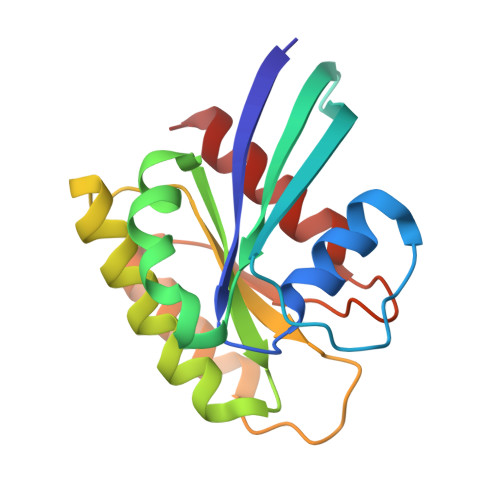Allosteric site variants affect GTP hydrolysis on Ras.
Johnson, C.W., Fetics, S.K., Davis, K.P., Rodrigues, J.A., Mattos, C.(2023) Protein Sci 32: e4767-e4767
- PubMed: 37615343
- DOI: https://doi.org/10.1002/pro.4767
- Primary Citation of Related Structures:
8ELK, 8ELR, 8ELS, 8ELT, 8ELU, 8ELV, 8ELW, 8ELX, 8ELY, 8ELZ, 8EM0, 8FG3, 8FG4 - PubMed Abstract:
RAS GTPases are proto-oncoproteins that regulate cell growth, proliferation, and differentiation in response to extracellular signals. The signaling functions of RAS, and other small GTPases, are dependent on their ability to cycle between GDP-bound and GTP-bound states. Structural analyses suggest that GTP hydrolysis catalyzed by HRAS can be regulated by an allosteric site located between helices 3, 4, and loop 7. Here we explore the relationship between intrinsic GTP hydrolysis on HRAS and the position of helix 3 and loop 7 through manipulation of the allosteric site, showing that the two sites are functionally connected. We generated several hydrophobic mutations in the allosteric site of HRAS to promote shifts in helix 3 relative to helix 4. By combining crystallography and enzymology to study these mutants, we show that closure of the allosteric site correlates with increased hydrolysis of GTP on HRAS in solution. Interestingly, binding to the RAS binding domain of RAF kinase (RAF-RBD) inhibits GTP hydrolysis in the mutants. This behavior may be representative of a cluster of mutations found in human tumors, which potentially cooperate with RAF complex formation to stabilize the GTP-bound state of RAS.
Organizational Affiliation:
Department of Chemistry and Chemical Biology, Northeastern University, Boston, Massachusetts, USA.

















